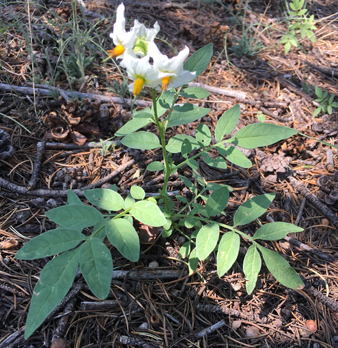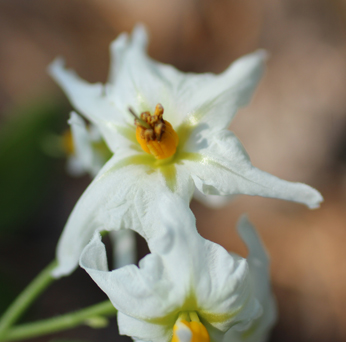
Location
On woodland trail on right after bridge #16 (N35D32'58.247 X W105D41'10.740)
Flowers first observed: 9/5/17
Plant w/Flowers

Flower

Distribution
"Colorado, Utah, Texas, Arizona; Mexico." (SEINet)
Description
"Herbaceous perennials to 45 cm tall, stems erect to spreading, herbage unarmed, glabrous to pilose or somewhat glandular, plants with rhizomes bearing tubers 10-15 mm in diameter. Leaves: Alternate, pinnate with 5-9 leaflets, 7-15 cm long, 4-9 cm wide, leaflets 5-13, lanceolate-oblong, 0.5-6 cm long, 0.5-3 cm wide, lower leaflets sometimes reduced, margins entire or nearly so, upper surface glabrous or nearly so, lower surface with short glandular pubescence. Flowers: White, actinomorphic (star-shaped), 5-angled or lobed, 3-3.5 cm in diameter, lobed for one-third or more to base, lobes 8-16 mm long, ovate-lanceolate to triangular-lanceolate, pubescent at the tips, calyx rotate to campanulate, to 6 mm long, lobes triangular-ovate to lanceolate, enlarged but not enclosing fruit, stamens 5, inserted on corolla tube, filaments short, style 10-14 mm long, much exceeding stamens, stigmas globose, flowers sometimes nodding, borne in few to several-flowered cymes, inflorescences leafy, branching or pseudoterminal at branch tips. Fruits: Leathery to juicy spherical berries slightly less than 1 cm in diameter, green throughout, not closely invested by the calyx."Colorado, Utah, Texas, Arizona; Mexico." (SEINet)
Ethnobotanical Uses
Food:
"Tubers - raw or cooked[1][2][3][4][5][6]. The tubers are rich in starch but are quite small, averaging only about 3cm in diameter[4][7]. The tubers range in size from a pea to a walnut[8]. There is a bitterness in the tuber, this is concentrated near the skin[4]. They can be stored for several months or can be sliced thinly, dried and ground into a powder for making bread etc[9][10]. The Hopi Indians cook them or eat them raw with a saline clay in order to counteract the astringency and also use them in making yeast[9][10]. The tubers are rather fiddly to harvest, apart from their small size they are also produced at the tips of roots, often at some distance from the parent plant[K]." (Practical Plants.org)
Medicine:
"Solanum is Latin for "quieting," in reference to the narcotic properties of some species, while jamesii is named after Dr. Frederick C. James (1935-2002). (SEINet)
Internet Links